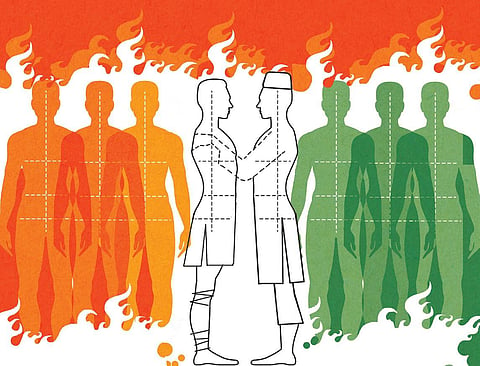

The communal clashes that erupted in Nuh in Haryana have once again exposed the dangerous fissures in our social fabric. The government may keep talking of sarvadharm sambhav and sabka vishvas, and those arrayed in Opposition may continue to shout themselves hoarse demonstrating their commitment to secularism, but the harsh reality is that religious/sectarian polarisation has pushed us to the edge of the precipice. From Manipur to the periphery of the national capital, those entrusted with maintaining law and order and preserving the rule of law remain petrified spectators unable to stem the tide of anarchy.
No purpose is served by apportioning blame or trying to find out who threw the first stone, fired the bullet or started arson and looting. Both sides in a riot claim to act in self-defence and the angry crowd always pleads for retaliation.
This time it was the Brijbhumi Jalabhishek Yatra procession that clashed with the persons of different creeds assembled near a mosque. What frayed tempers was that this yatra was passing through an area with a Muslim majority population during the time of mourning, Muharram, which the Shia sect observes with solemnity and silence. (It may be noted that Nuh doesn’t have a large Shia population.) Another distressing report from Bareilly informed us that the SSP was transferred hours after he had ordered a lathi charge to disperse kanwar yatris who, in his judgement, were threatening to merge and mingle with a Muharram procession, creating a serious breach of peace. Local people agree that timely action averted violence, which could have spiralled out of control. Ironically, this officer is the son of a veteran BJP leader who has since resigned from the party in protest.
These aren’t isolated cases. Yatras that have mushroomed in recent decades provoke ugly clashes that can be encashed at the time of elections. It isn’t only the kanwariyas—devotees of Lord Siva who have modernised the sacred pilgrimage with disco music, express kanwar and relay race format—the mourners in Muharram too have included electronically amplified drum beating, wailing and musical laments. Many Shias, true to their faith, have criticised this sacrilege. But perhaps it’s unfair to equate all processions that profane the sacred and openly flout the law of the land. Some are emboldened by helicopters showering rose petals on them, rest and recreation stations being erected along the routes (that are seldom followed), and others are bluntly told that the feelings of the majority can’t be hurt under any circumstances. There is a limit—to their and the government’s tolerance. This isn’t the place to get into issues like tolerance of Sanatan Dharma or the injustices Hindus have suffered at the hands of invaders that need to be redressed by vigilantes.
What we wish to focus on are the distortions that yatras, processions and marches have suffered in recent years. To begin with, there were tirth yatras, prescribed pilgrimages for the faithful—Kailash Mansarovar, Chaar Dham, Dwadash Jyotirlingam, Narmada Parikrama, Sabrimala, Amarnath Yatra and Tirupati. Remote rural communities have traditionally followed arduous pilgrimages like Nanda Devi Raj Jat in Uttarakhand.
The Sikhs have their hallowed circuit to Hemkund Sahib, the Golden Temple and other gurdwaras associated with the great Gurus. The Muslims perform the Haj and many also pay respect to dargahs of Sufi saints—Ajmer Sharif and Nizamuddin Auliya’s dargahs are equally popular among Hindus and non-Hindus. Buddhists, from all over the world, flock to Bodh Gaya, Sarnath and Sanchi. Sacred spots for Jains are distributed all over the map. Goa and Kerala are inheritors and custodians of Christian places of worship. All these tirth yatras have coexisted peacefully and celebrated harmoniously. Sadly, pilgrims on Amarnath Yatra have been attacked by terrorists to sow seeds of dissension. Khalistani separatists settled abroad have weaponised the creed that preaches compassion and peace. Evangelical missionaries have accelerated the forging of a separate non-Indian identity for large sections of the tribal population. The ethnic/sectarian bloodshed in Manipur has exposed that the Gospel alone can’t heal age-old prejudices or provide defence against senseless violence.
Words, alas, have changed meanings. The Dandi March was a defiant, but non-violent expression of satyagraha. Today, the word ‘march’ evokes images only of a flag march by soldiers in a battle dress trying to restore peace by show of force. Memories of padyatra—foot marches covering vast tracts of often hostile territory—by JP and Vinoba for bhoodan and surrender of dacoits have faded from memory.
The Supreme Court leaves us bewildered: hair-splitting between public interest and larger public interest, invoking national interest to overrule their own decisions granting seemingly unending extensions to indispensable civil servants. The situation is so bleak that a high court judge felt constrained to announce his resignation in open court. How then can the victims of violence, resulting from the total breakdown of law and order, retain hope for justice?
Pushpesh Pant
Former professor, Jawaharlal Nehru University
pushpeshpant@gmail.com